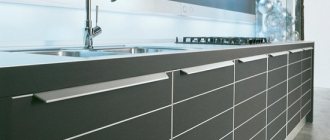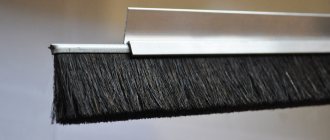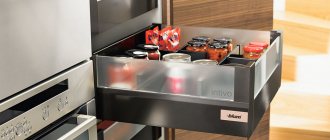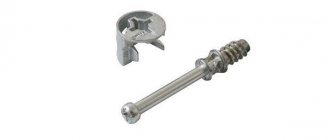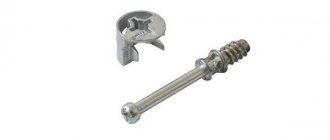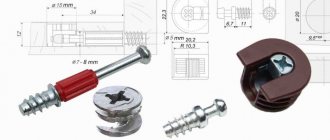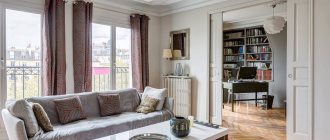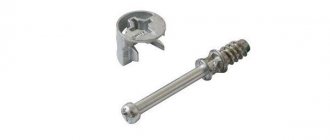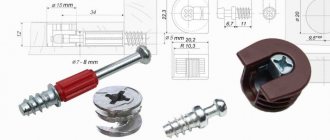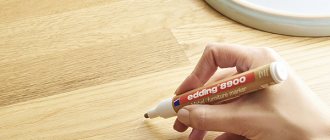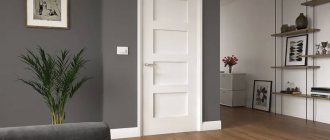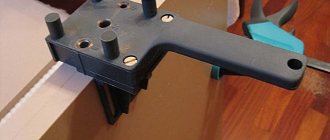High-quality fasteners guarantee the durability of furniture
The service life of furniture directly depends on the fastening fittings used during assembly. To speed up this process today they use:
- Corner and body ties for insertion or pressing, hinges, bushings, connectors.
- Metal confirmations, characterized by strength, reliability and low price.
- Shelf holders with plugs that secure the structure and can replace tie rods.
- Minifixes invisible from the front side, which can be installed even by those who do not have such experience.
- Hardware products of various sizes: dowels, screws, couplings, screws, hanging hooks.
Properly selected furniture fasteners, taking into account all the details, will certainly extend the life of the furniture and make operation more comfortable.
Furniture fittings. Types and application. Peculiarities
Furniture fittings are auxiliary materials and accessories used in the production of furniture. Furniture fasteners are often considered accessories, although these are two different categories of elements for assembly. Fittings provide a supportive and decorative effect, while fasteners usually have only a functional use and hold furniture pieces in place.
What types of furniture fittings are there?
The list of accessories includes:
- Loops.
- Guides.
- Shelf supports.
- Pens.
- Supports.
- Hooks.
- Locks.
- Shock absorbers.
- Bumpers.
- Magnets.
- Closers.
- Railing pipes.
Loops
They are one of the most important accessories. They are used for movable fastening of doors and sashes. Their principle is similar to the operation of ordinary hinges for interior doors, but they are smaller in size. There is a huge range of accessories on sale, the price of which can vary tenfold. The most budget-friendly are hinges that provide hidden installation, which can only be seen after opening the doors or sashes. Most of the time they are invisible, so there is often no need to buy attractive, expensive accessories.
Conventionally, all furniture hinges can be divided into 3 categories for:
- Chipboard and MDF.
- Array.
- Glass.
The hinge used for fastening furniture made of chipboard and MDF provides for preliminary insertion into the material to provide a larger contact area for fastening. The fact is that chipboard and MDF have insufficient density, so screws screwed into them can break out under load. Installing such accessories requires a lot of time, but using other methods of fixing the door will be less reliable. The insertion for the hinge is carried out using a feather-type wood drill.
For natural solid wood furniture, special hinges are used that have a classic look and resemble accessories for interior doors. They are simply applied to the door and the base of the furniture, after which they are attached using self-tapping screws. Often such furniture fittings remain noticeable, so they make them more attractive.
Special hinges are used for glass furniture. Each half consists of two parts, which, like a vice, press the glass part, preventing it from slipping out. They usually require pre-drilling into the glass to install them, but this is not mandatory. More expensive fittings will allow you to fix the doors even without preparing the holes. Often such loops are combined. On one side they provide for fixation to a glass door, and on the second to chipboard, MDF or solid wood.
Guides
This furniture fittings are designed to ensure the fixation of furniture boxes and the direction of their movement when removing and pushing in. Almost all furniture equipped with drawers that is produced in factories has metal guides. Wooden slats along which the drawers move, an outdated method no longer used. Typically, guides provide sliding on rollers. Thanks to this, they move smoothly with minimal noise and effort.
Guides for each drawer are sold in pairs. One is designed to be mounted on the right, and the second on the left. Each such element consists of 2 parts. One is screwed to the side of the cabinet or cabinet, and the second is screwed to the bottom of the drawer. There are other designs of guides that use balls instead of rollers.
Shelf supports
Shelf holders are used to secure removable shelves in cabinets and cabinets. They act as a limiter that prevents the overhead shelf from falling under load. Cylindrical shelf holders made of metal are common. There are 4 of them used on each shelf. These are the most budget products. Their disadvantage is the small contact area with the surface of the shelf, so they are usually used only in structures that will be subject to minor loads. More stable are holders with a shelf, which usually represent something between a cylindrical accessory and a connecting corner.
Shelf holders with a clamp are used to secure glass shelves. They are usually visible, so they are made from a more attractive material. Metal coated with chrome or paint is often used.
Pens
Almost all furniture that is equipped with doors and sashes is equipped with handles. Such furniture fittings have the most extensive range. Its cost can vary tenfold. Handles can be in the form of slats, shells, buttons, etc. It is on this fitting that designers most often focus their attention, since it remains noticeable. Handles are constantly touched to open a drawer or door. In this regard, they must be made of high-quality wear-resistant material. Cheap pens are made of wood and plastic. The most expensive fittings are those with an artistic twist, for example, those made in the shape of a leaf or an animal’s head.
Supports
This fittings are not the most popular, since not all types of furniture provide for its use. The supports are represented by legs and rollers. They are usually used on sofas and armchairs. Cabinets and desks have support around their entire perimeter, so separate legs are not needed.
The simplest feet are rubber pads that soften the harsh pressure on the floor covering. More expensive fittings have the ability to adjust the height. It is used when there is unevenness in the floor. These legs consist of two parts. The first is attached to the bottom of the furniture, and the second is twisted, changing the height. Thus, even if the floor has a slope, the surface of the furniture can be leveled.
Hooks
Such furniture fittings are used to equip cabinets and hallways. Clothes are hung on it using a loop. Hooks can be single or double. Their size determines what kind of clothes you can hang. Small ones can be attached to a jacket and coat. Large hooks can hold hats.
Locks
For furniture that has sections for storing valuables, special locks have been developed. They differ from classic door ones in their smaller dimensions. Naturally, the degree of their protection is very conditional. It will not be difficult to tear out a door with a lock if desired, but it will be noticeable, so such furniture fittings still have a place. You can also find quite reliable locks on sale, but it is advisable to install them only on solid wood products. Natural wood is more resistant to mechanical pressure, so it will not allow the screws holding the lock to break out. In the case of chipboard or MDF, it is the material itself that will fail, not the lock, so there is no need to overpay when purchasing it.
Shock absorbers
This is a relatively new type of fittings that allows horizontal doors to be opened and held open. They are typically used in overhead wall kitchen cabinets. These accessories are completely identical to gas shock absorbers that raise the trunk lid of passenger cars. They are classified according to the weight they need to hold. For small thin doors, budget shock absorbers are used, but if you have to support serious weight, you will have to spend money, because if the shock absorber fails, then a falling door can cause injury.
Bumpers
This is a budget simple fitting that usually comes in the form of a small sticker. Sometimes there are bumpers in the form of a pushpin or equipped with a nail and a rubber pad on its head. They are installed in furniture at the ends where it is in contact with the front of the drawer or opening doors. The soft surface of the bumper prevents a strong impact in case of careless closing of the furniture and prevents damage to it. The use of this fitting reduces the loudness of closing drawers and doors.
Magnets
This furniture fittings are used less and less due to the advent of more advanced mechanisms. It consists of two elements: a metal plate and a magnet. The trim is screwed to the inside of the door, and the magnet is directly opposite, to the bottom of the cabinet or cabinet. When the door is closed, it is held in place so it does not open on its own.
Closers
This fitting is one of the most expensive. It is something between a gas shock absorber and a bump stop. Its function is to stop the closing door or flap just before final closing. If you lower the doors, they will not slam, but will slowly close. Sometimes closers are mounted in hinges, which is the most successful option. Budget fittings are supplied separately. In this case, it acts as a soft shock-absorbing bumper, capable of only stopping movement without pulling the door behind it. Such a closer is suitable for installation only if the hinges tend to press on the doors independently when closing.
Railing pipes
To equip cabinets, pipes and rod guides are used, which ensure the fixation of hangers with clothes. They are made of steel or aluminum. This fitting is subject to heavy loads, so it is made quite durable. It is advisable to choose a stainless steel pipe whose surface is polished rather than painted, since over time the paint will come off due to friction on the hanger hooks. Sometimes such pipes can be found in the kitchen, where ladles and other accessories are hung on them.
Related topics:
- Klyammer. Types and application. Work and features. How to choose
How to choose and buy fasteners of proper quality
The employees of our online store, specializing in the sale of furniture accessories, are well versed in all the nuances of the products presented on the website and strive to share their knowledge with every potential client. We guarantee:
- Help from an experienced specialist in selecting suitable parts.
- Timely shipment of the ordered batch of goods from a warehouse in Moscow.
- Competitive prices for basic and additional services.
- A wide selection of mechanisms to implement the assigned tasks.
You can order and buy connecting elements from us in two ways: by calling the manager on one of the indicated telephone numbers or by leaving an online request on our resource.
